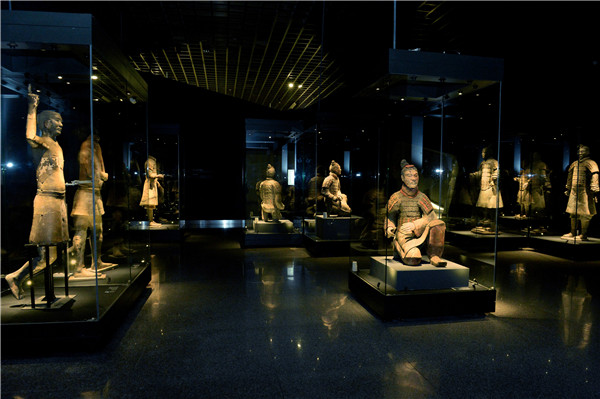Restoring color to China's Terracotta Warriors
( Xinhua ) Updated: 2017-09-23 07:33:34
 |
|
The life-size Terracotta Warriors were first discovered in 1974 from the tomb of Emperor Qinshihuang, China's first emperor. [Photo/Xinhua] |
Ongoing exhibition shows how researchers are repairing precious relics.
Four minutes. Just four minutes is all it takes for the rarest colors on Earth to fade in front of a pair of human eyes. Han blue and Han purple, also called Chinese blue and Chinese purple, are made of synthetic barium copper silicate.
The pigments were first used in paint in the Qin Dynasty (221-206 BC), and in large quantities in the Terracotta Warriors unearthed from the tomb of Emperor Qinshihuang, China's first emperor, who lived between 259-210 BC.
"Almost every warrior and horse was painted, but after more than 2,200 years the pigments were so old they began to change just 15 seconds after they were unearthed, and within four minutes the lacquer layers that were bound with the pigments broke from the surface," says Xia Yin, director of relics protection department at Emperor Qinshihuang's Mausoleum Site Museum.
"Before the artifacts were unearthed, they were protected by a cooler and more humid underground environment," says Xia, who has spent more than 20 years researching the artifacts.
The life-size clay figures were first discovered in 1974 in the underground mausoleum, the world's largest. But there were no advanced techniques to properly protect the warriors, Xia says.
"Photographers did not have the time to take a picture before the paints began to disappear," he said.
For the last 20 years, Chinese researchers have collaborated with German scholars on preserving colors on pottery.
An exhibition is on in Xi'an, capital of Shaanxi province, where the mausoleum is located, to show the progress researchers have made in retaining the colors of the excavated artifacts. The exhibition started on Aug. 30 and will last three months.
|
|
|
|
|
|
|
|

























 Raymond Zhou:
Raymond Zhou: Pauline D Loh:
Pauline D Loh: Hot Pot
Hot Pot Eco China
Eco China China Dream
China Dream China Face
China Face






